
This page is part of © FOTW Flags Of The World website
Emblems of the Tribes of Israel
Last modified: 2024-09-14 by martin karner
Keywords: israel | tribes | mandrake | gate | ephod | lion | scales of justice | gazelle | camp | olive tree | corn | sun | stars | donkey | camel | ship | sheaf | wolf | barton's |
Links: FOTW homepage |
search |
disclaimer and copyright |
write us |
mirrors
See also:
Presentation
These flags [of the individual tribes of Israel] were
published some months ago in Banderas, but I don't have
drawings of them, because I think that probably they are a bit
fantasious.
Jaume Ollé, 5 May 1998
There is a biblical reference to the tribal flags as well that
a friend of mine sent me some months ago, to whit: (Book of
Numbers, Chapter 2, Verse 2) "The children of Israel
shall encamp every man by his own standard, with the ensigns of
their father's houses". The book the Standard Bible
Encyclopedia has this and other biblical references under the
heading of "Banner" that might be interesting to list
members.
Greg Biggs, 5 May 1998
The following article about the Tribes of Israel is taken from
a CD on Israeli stamps that was just released (I was one of the
philatelic advisors). The CD has full-colour images of all the
stamps of Israel plus articles on them (like this one) as well as
stationaries, booklets and ATM labels. It costs about US$ 80. The
stamps were issued in 1955/56 as a definitive series, Scott
105/116, SG 115/126, Yv 97/108, Mi 119/130, Bale 118/119. (see stamp series Tribes of Israel)
This set of stamps features the emblems of the 12
tribes of Israel. Each stamp bears a single tribal emblem,
part of them in combination with other motifs. The symbols of
the tribes are by no means fixed as different interpretations
may be given to the biblical texts describing the sons of
Jacob.
The 12 tribes of the House of Israel are the
descendants of the Patriarch Jacob and his two wives, Leah
and Rachel, and his two concubines, Zilpah and Bilhah. Leah
had six sons – Reuben, Simon, Levi, Judah, Issachar, and
Zebulun. Each of the other women had two sons each. Rachel's
were Joseph and Benjamin; Zilpah's, Gad and Asher; and
Bilhah's, Dan and Naphtali.
In Jacob' Blessing (Genesis 49) each of the sons is
described allegorically and symbols for the tribes have been
derived from these descriptions as well as form other
biblical passages. Interesting descriptions of the tribal
symbols are found in a rabbinical commentary on the Bible,
the Midrash Rabba (c. 3rd century), which describes the flag
of each tribe. The emblems of the tribes, however, found no
expression in graphic art in earlier ages.
That the number of the tribes bears some relation to
the zodiac follows from the hints which accompany different
names mentioned in Jacob's Blessing. Simon and Levi, there
noted together, are the Twins, Judah is described as a Lion;
Dan as Scales, and Benjamin as Wolf. In the Wars of the Jews
(4, 5) Flavius Josephus also mentions that the 12 shewbreads
in the Temple represented the zodiac.
- REUBEN
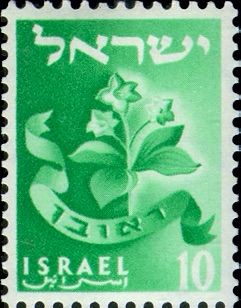 (source)
(source)
- The mandrakes in Reuben's coat-of-arms are based
on the episode related in Gen. 30, where young Reuben
brought his mother Leah mandrakes from the field. The
biblical phrase on the tab is from Deut. 33:6,
"Let Reuben live." (stamp info > scroll down)
- SIMEON
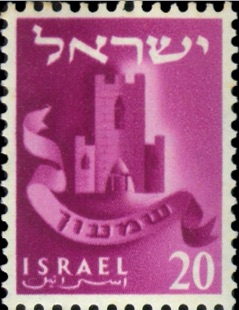 (source)
(source)
- Simeon was one of the strongest tribes during the
wandering in the desert but later became one of the
weakest in consequence of losses suffered during the
battles for the Promised Land. It was eventually
absorbed by mighty Judah. Formerly the city of
Shechem was situated within the boundaries of Simeon
and the gate of the city therefore appears on the
tribe's. The biblical phrase on the tab is from Deut.
33:5, "... and the tribes of Israel were gathered
together." (stamp info)
- LEVI
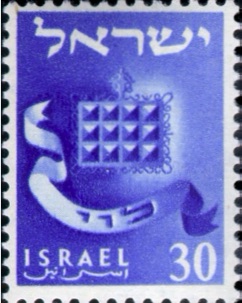 (source)
(source)
- The Levites "kept the charge of the
tabernacles of testimony" (Num. 1:53); they had
no territory of their own and were dispersed among
the other tribes. Their emblem was the ephod of the
High Priest on which were engraved, upon precious
stones, the names of all tribes. The biblical phrase
on the tab is from Deut. 33:10, "They shall
teach Jacob thy judgments, and Israel thy law." (stamp info)
- JUDAH
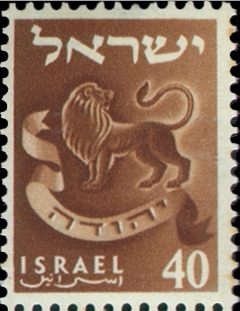 (source)
(source)
- The most famous heraldic symbol belongs to the
tribe of Judah, which displayed a lion on its shield.
This tribe became the most powerful and constituted
the Kingdom of Judah. The lion is the symbol of
strength and is featured as such in innumerable works
throughout the ages. This animal is one those most
frequently mentioned in the Bible, appearing about
130 times under 6 different names. The biblical
phrase on the tab is from Gen. 49:9, "Judah is a
lion's whelp." (stamp info)
- DAN
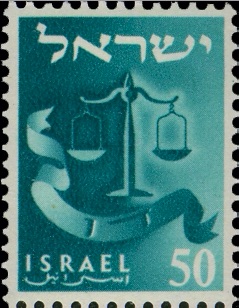 (source)
(source)
- The original area of the tribe of Dan extended
from Jaffa southward. Samson was a son of this tribe.
As it could not conquer its entire territory, Dan
looked to settle elsewhere and the tribe moved north
to the source of the Jordan River, captured the city
Laish, and settled there. In Jacob's Blessing Dan was
promised that he "shall judge his people"
(Gen. 49:16), a reference symbolized by the scales of
justice on the stamp. The phrase appears on the tab. (stamp info)
- NAFTALI
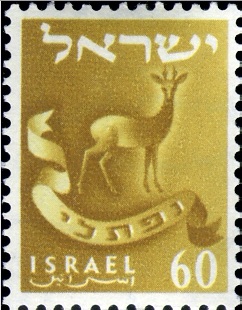 (source)
(source)
- After the conquest of the country, the tribe of
Naftali settled in the north where played a central
role among the tribes located there. Naftali is
represented by a gazelle or running stag. The
biblical phrase on the tab is "Naftali is a hind
let loose" (Gen. 49:21). (stamp info)
- GAD
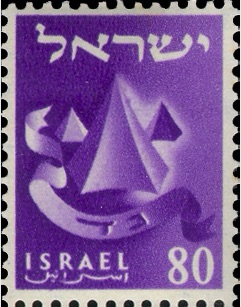 (source)
(source)
- The tribe of Gad settled in the land of Gilead,
east of the Jordan. It did battle against Amon and
Moab coming from the south, wandering tribes from the
east, and Aram from the north. The emblem resembles a
camp in reminiscence of the biblical phrase -on the
tab- "Gad, a troop shall overcome him"
(Gen. 49:19). (stamp info)
- ASHER
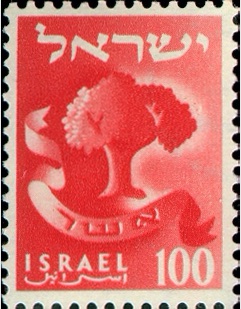 (source)
(source)
- The coastal strip from the foot of Mount Carmel
up to Sidon was inhabited by Asher, the fertility of
whose land was indicated by an olive tree or – as
represented on stamps of the Jewish National Fund or
in the synagogue of Achen, Germany – by ears of corn or fruit. The biblical
phrase on the tab is "Out of Asher his bread
shall be fat" (Gen. 49:20). (stamp info)
- ISSACHAR
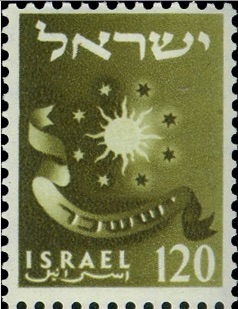 (source)
(source)
- Issachar's territory was the plain of Esdraelon,
from the sea to the banks of the Jordan. This tribe
is frequently mentioned together with Zebulun
indicative of their being neighbors and maintaining
close relations. The tribe's emblem of sun and stars
is derived from the biblical phrase, "And of the
children of Issachar, which were men that had
understanding of the times" (1 Chron. 12:32),
which appears on the tab. Other representations of
Issachar reflect the dependence of this tribe on the
Phoenicians, in whose products the tribe dealt –
as a carrier of loads (see also Menorah stamp), as a
donkey (on the Jewish National Fund stamp), or as a
laden camel (in the synagogue of Aachen, Germany).
(stamp info)
- ZEBULUN
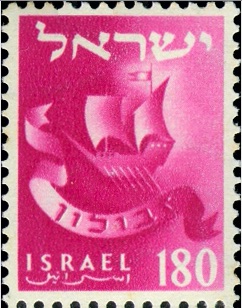 (source)
(source)
- Zebulun settled on the country's seaboard and as
symbolized by its emblem was engaged in navigation.
This idea is conveyed in the biblical phrase,
"Zebulun (...) shall be for a haven of
ships" (Gen. 49:13). (stamp info)
- JOSEPH
 (source)
(source)
- Joseph was the principal tribe in central Eretz
Israel, which split into Manasseh and Ephraim. The
fertility of Joseph's country is symbolized by the
sheaf on the stamp. The biblical phrase on the tab
reads, "... blessed of the Lord be his land"
(Deut. 33:13). (stamp info)
- BENJAMIN
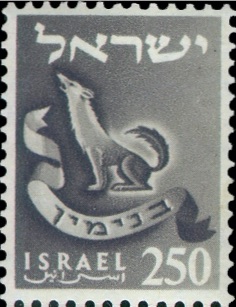 (source)
(source)
- The favorite son of Jacob, Benjamin has remained
the symbol of the tender youngest child. The tribe of
Benjamin, however, was considered particularly
warlike and courageous. To this tribe belonged Saul,
the first king, and Jonathan, his son. The symbol of
the tribe was the wolf, a predatory animal. The
biblical phrase on the tab reads, "... in the
morning he shall devour the prey" (Gen. 49:27). (stamp info)
Notes:
- I disagree to the use of the terms coat-of-arms
and heraldic in the article. I believe that heraldry is a well-defined
European concept that began more than two millenia after
the Tribes of Israel.
- There is a confusion about the 12 tribes. Those on the
stamps are the sons of Jacob, but there was no tribe of
Joseph – only tribes of Menasseh and Ephraiym, his
sons. Levi was not regarded as a tribe either because the
Levites were the priests and they had no territory of
their own.
- The Lion of Judah is the origin of the city emblem of Jerusalem that is on the city
flag. It is also (in a different design) the emblem of
the IDF Central Command which has
its HQ in Jerusalem. One of the Command Generals in the
70's had a cage with a live lion there!
Nahum Shereshevsky, 5 May 1998
The emblems of the Tribes are commonly used as decorations in
official ceremonies, like the ceremony that closes Memorial Day
and opens Independence Day.
Nahum Shereshevsky, 2 June 1998
I scanned stamps of the symbols
of the 12 tribes.
Dov Gutterman, 1 June 1999
This Saturday the portion "Bamidbar" (the beginning
of the book of Numbers) was read in the synagogue; flags of the
tribes of Israel are mentioned there. Exact descriptions are not
given in the Biblical text itself, but two commentaries do
describe them, and I was pleasantly surprised when my rabbi's
short speech today focused on the design of the flags.
In short, one commentary assigns a flag to each of the twelve (or
thirteen) tribes (related but somewhat distinct from the emblems
described here), while another assigns a flag to each
"camp" (a group of three tribes, for a total of four
"camps").
Nathan Lamm, 31 May 2003
I went into the biblical texts mentioned by Nathan and found
in the St James version of the English translation dating from
the early 18th century (Numbers 2 Vers 2) the following:
"Every man of the children of Israel shall pitch by his own
standard, with the ensigns of his father's house ...".
The revised standard version of the Bible's English translation
dating from 1952 renders the same verse as follows:
"The people of Israel shall encamp each by his own standard,
with the ensigns of their father's houses ...".
Considering the age when the original Book of Numbers book was
likely written (between 1000 and 800 BC?), I have always thought
that this reference to standards and ensigns to be English
interpretations of the ancient Hebrew words which might possibly
have referred to emblems that we in modern times would term
vexilloids. Nathan's mention of rabbinical commentaries providing
descriptions of actual flags, would to my mind be an exciting
discovery of a very early use of actual flags not encountered in
any other historical sources. (According to Whitney Smith, W.G.
Perrin et al, the first real flag in the West was probably the
Roman vexillum).
Andre Burgers, 1 June 2003
I think one of the commentaries dates to about the year 100,
and the other to about the year 200 (but possibly based on much
older traditions). So it's entirely possible that the rabbis who
wrote them were influenced by Roman flags when interpreting the
verse. Of course, as they use the same Hebrew terms as the
Biblical text itself, they may simply be referring to the same
objects as the Bible – and yet they do seem to be clearly
referring to a piece of cloth with a design, hung in whichever
way.
Nathan Lamm, 1 June 2003
Here is a scan (part 1,
part 2) of the 12
tribal flags according was published in "Banderas".
Jaume Ollé, 1 June 2003
The flags just posted are, I believe, from a ceremony a few
decades back in Israel. There are some errors in the
transcription (Asher and Simeon are transposed, etc.);
furthermore, there are some differences with the original
accounts. The two rabbinic commentaries on the flags of the
tribes are Numbers Rabbah and Pseudo-Jonathan.
Numbers Rabbah is a Midrash, part of the collection
called Midrash Rabbah, the Great Midrash. A Midrash
(there are about a hundred) expounds (the meaning of Midrash)
on verses in the Bible, whether to determine Jewish law or, on
the other hand, history, lore, and so on from them. They were
written over a large span of time, from about the first century
until about the tenth. (Some collections came out in the next few
centuries) Numbers Rabbah was written in about the ninth century.
It's in Hebrew, and the translation below is my own.
Pseudo-Jonathan is a Targum, that is, a translation of
the Bible (here, the first five books) into Aramaic. There are
several Targums, of different style. Some are simple
translations with minimal exposition, but Pseudo-Jonathan gives
much commentary among its translation- all of what is below is
not in the actual Biblical text. (The actual Targum Jonathan
covers the Prophetic books, not the first five. This is actually
the "Jerusalem Targum" [it was written in Israel], but
someone mistook the initials "T.J." [actually
"T.Y."] for Targum Jonathan, because of the
other Targum of that name, and the name stuck, hence the
use of the term "Pseudo-Jonathan.) This Targum was
written in about the seventh or eighth centuries. The translation
from the Aramaic is my own; as my knowledge of Aramaic isn't as
good as my knowledge of Hebrew, it's a bit rougher.
An important note: Although the two works date from when I wrote
above, each uses sources that were much older, perhaps dating to
the first or second centuries. These sources, in turn, may have
been based on even older traditions, perhaps dating back to the
time of the writing of the Bible and/or the events described
therein. Going back that far, one would have to see what the
vexillological customs of the ancient Mesopotamians (the place of
origin of the Israelites), the ancient Canaanites/Phoenicians
(where they had come from and where they were going) and the
ancient Egyptians (where they had just come out of) were. Of
course, it is hard to tell what portions of these two works have
long traditions behind them and what portions do not, and one
cannot discount the fact the descriptions of flags here are
undoubtedly influenced by flags that existed in the early Middle
Ages, when they were written. The word "flags" here may
thus mean "banner" or "strip of cloth" or
"vexillum" or perhaps even "flag" in our
modern sense. However, the original standards, if any, may have
been an object (a vexillloid) of some sort. (Note that the
Midrash attributes the widespread use of colored cloth flags to
the example of the Israelites!)
Numbers Rabbah, 2:7, commenting on Numbers Chapter 2, Verse 2
("Each man according to his degel ["division", but
modern: "flag"] under the otot
["standards"] of their fathers' houses shall the
Children of Israel camp ..."):
BeOtot ("Under the standards"): Each prince
[of each tribe] had symbols, a mapah ["cloth,"
"spread," hereafter "flag"], and the color of
each flag was like the color of the fine stone that was on the
heart of Aaron [the High Priest]. [The breastplate of the high
priest contained twelve precious stones, one for each tribe. The
exact definition of each is not known, so the Hebrew is given
here; hints may be taken from the colors and are given as well,
but therefore may only match some of the colors given.] From this
the kingdoms learned to make flags and a color for each flag. For
each tribes' prince, the color of the flag was similar to the
color of its stone.
– Reuben's stone was Odem [carnelian? ruby?], and the
color of his flag was red, [a picture of] mandrakes was drawn on
it. [Mandrakes figure in a story about Reuben, the founder of the
tribe, Genesis 30:14.] [I'm not sure where the imagery of a
rising son comes from – Reuben being the eldest?]
– Simeon's stone was Pitedah [emerald?], and the color
of his flag was green, and [a picture of the city of] Shechem was
drawn on it. [Simeon, together with Levi, destroyed that city,
Genesis 34.]
– Levi's [stone was] Bareket [topaz? carbuncle?
smaragd?], and the color of his flag was a third white, a third
black, and a third red [think of a banded stone], and [a picture
of] the Urim VeTummim [that is, the twelve-stone
breastplate {the Urim VeTummim were within}- a square,
four rows of three stones each, usually horizontal but sometimes
vertical] was drawn on it. [The priesthood was drawn from the
tribe of Levi, and the whole tribe participated in holy service.]
[Levi is omitted from the list by some, as he was not counted
among the others, with the two tribes of Joseph making up the
total of twelve.]
– Judah's [stone was] was Nofekh [carbuncle? topaz?],
and the color of his flag was sky blue, and [a picture of] a lion
was drawn on it. [Judah, from whom the monarchy descended, is
compared to the king of beasts in Genesis 49:9, the blessing of
Jacob.]
– Issachar's [stone was] Sapir [sapphire?], and the
color of his flag was like azure [some: black], and [a picture
of] a sun and a moon was drawn on it, because [as it says in I
Chronicles 12:33] "And from the sons of Issachar were those
who knew the wisdom of the times [i.e.,astronomy and
calendars]". [Jacob's blessing calls Issachar a "laden
donkey," and sometimes the symbol is shown as that or as a
laden man.]
– Zebulon's [stone was] Yahalom [beryl?], and the color
of his flag was white [according to some, like silver {similar to
heraldic rules today} because of his wealth], and [a picture of]
a ship was drawn on it, because [as it says in Genesis 49:13]
"Zebulon shall dwell by the seashore [i.e., engage in
trade]."
– Dan's [stone was] Leshem [jacinth?], and the color of
his flag was like a sapphire [others: black], and [a picture of]
a snake was drawn on it, because [as it says ibid. 17] "Dan
shall be [as] a snake [when he attacks from an ambush]." [As
Dan's descendants were judges, scales are sometimes shown as
well.]
– Gad's [stone was] Shevo [agate?], and the color of his
flag was not white and not black but a mixture of black and white
[gray?], and [a picture of] a camp was drawn on it, because [as
it says ibid. 19] "Gad shall camp in troops" [Heb: Gad
Yegud Yegudenu, a reference to his fighting strength].
[Sometimes actual troops, not tents, are shown.]
– Naftali's [stone was] Achlamah [amethyst?], and the
color of his flag was like diluted wine (whose red [color] was no
longer strong), and [a picture of] a deer was drawn on it,
because [as it says ibid. 21] "Naftali shall be as a sent
deer [i.e., he was fast]".
– Asher's [stone was] Tarshish [chrysolite?], and the
color of his flag was like the expensive stone women decorate
themselves with [pearl? opal?] [others: olive, or the light given
by olive oil], and [a picture of] an olive tree was drawn on it,
because [as it says ibid. 20] "From Asher will be his rich
bread [i.e., he will live in a fertile area]". [Sometimes
other signs of agricultural wealth – a cornucopia, say – are
shown.]
– Joseph's [stone was] Shoham [onyx?], and the color of
his flag[s] was very black, and the [picture] drawn on it for the
two princes [of] Ephraim and Menasseh was Egypt [a pyramid?],
because they were born in Egypt. And on the flag of Ephraim was
drawn an ox, because [as it is written in Deuteronomy 33:17]
"His first born is his ox," this is [a reference to]
Joshua who was from the tribe of Ephraim [in addition, although
the younger brother, Ephraim's was considered the senior tribe,
and Genesis 49 calls Joseph an ox as well]. And on the flag of
Menasseh was drawn a re'em [a sort of wild ox], because
[as it is written Deuteronomy ibid.] "And the horns of the re'em
will be [as] his horn," this means Gideon son of Joash who
was from the tribe of Menasseh. [There is a question what this
means: Was there one black flag with an overall picture of Egypt
plus the two animals, or a flag with Egypt for the whole Joseph
and a flag for each tribe, or just aflag for each tribe?]
– Benjamin's [stone was] Yashpeh [jasper?], and the
color of his flag was like all the colors of the twelve colors,
and [a picture of] a wolf was drawn on it, because [as it says
Genesis 49:17] "Benjamin is like a scavenging wolf".
Therefore [the word] "BeOtot" [literally "in the
signs"] is used, for there were symbols for each prince.
[End of Numbers Rabbah translation.]
Targum Pseudo-Jonathan reads the verse as giving not one flag to
each tribe, but one flag for each "camp" – that is, each
of the four groups of three tribes each. He also sees the stones
on the breastplate as being arranged for the tribes not in the
order above (by mother, then by age) but according to the camps.
Thus his commentary on the following verses:
– Numbers 2:3: "... [the camp of Judah's] Tekes
(lit. "troop" [?], here clearly "flag") had
three stripes, each like three of the stones of the breastplate, odem,
pitedah, bareket. On it were written the names
of the three tribes, Judah – Issachar – Zebulon, and (in
the center[?]) the verse [Numbers 10:35] 'Arise, Lord, and
may Your enemies be scattered, and may those who hate You flee
before You!' and there was a picture of a young lion
[Genesis 49:9, "Judah is a young lion ..."] on
it ..."
– Numbers 2:10: "... [the camp of Reuben's] flag had three
stripes, each like three of the stones of the breastplate, nofekh, sapir, yahalom.
On it was written the names of the three tribes, Reuben –
Simeon – Gad, and (in the center[?]) the verse [Deuteronomy
6:4] 'Hear Israel, the Lord is our God, the Lord is
One.' And there was a picture of a young deer [ram?]
[originally to have been a calf, but changed because of the sin
of the golden calf, hence the verse, with "rams"
symbolizing Israel] on it ..."
– Numbers 2:18: "... [the camp of Ephraim's] flag had three
stripes, each like three of the stones of the breastplate, leshem, shivo, achlamah.
On it was written the names of the three tribes,
Ephraim – Menasseh – Benjamin, and (in the center[?]) the
verse [Numbers 10:34] 'And the cloud of the Lord was above
them during the day when they traveled from the camp.' And
there was a picture of a young boy [Jeremiah 31:19, "Ephraim
is my dear son..."] on it ..."
– Numbers 2:25: "... [the camp of Dan's] flag had three
stripes, each like three of the stones of the breastplate, tarshish, shoma, yashpeh.
On it was written the names of the three tribes, Dan –
Naftali – Asher, and (in the center[?]) the verse [Numbers
10:36] 'Return, Lord, the myriads of thousands of
Israel!' And there was a picture of a snake [Genesis 49:17,
"Dan shall be [as] a snake ..." {see above}] on
it ..."
Nathan Lamm, 5 June 2003
In "modern" Hebrew, the stones are translated as
follows:
Odem: Ruby
Pitedah: Topaz
Bareket: Emerald
Nofekh: Not in use as stone name today
Sapir: Sapphire
Yahalom: Diamond
Leshem: Opal
Shevo: Not in use as stone name today
Achlamah: Amethyst
Tarshish: Not in use as stone name today
Shoham: Onyx
Yashpeh: Jasper
Dov Gutterman, 5 June 2003
First of all, while the Twelve Tribes of Israel, or Shivtei
Yisrael, as they are known in Hebrew, did indeed have what
we might term in contemporary usage heraldic signs and devices,
all of which are mentioned repeatedly in the bible. There is no
Tanachic record of the Tribes ever actually possessing, much less
using flags of any sort. Any such items are purely fictitious in
nature, having been invented not earlier than the Protestant
Reformation and probably much more recently. Any flag which you
have seen which claims (or has claimed for it) that it belonged
to any or all of the Twelve Tribes is absolutely, completely, and
totally spurious.
Incidentally, the State of Israel has over the years issued
several series of postage stamps which depict the heraldic
devices of the Twelve Tribes; you can find these illustrated in
Scott's Standard Postage Stamp Catalogue or in Stanley Gibbons'
Stamps of the World Catalogue. Believe me, if the Twelve Tribes
had had any flags the Israelis would have issued postage stamps
commemorating the fact.
What might have been the case was that in battle some or all of
the tribes may have borne standards containing a depiction of
their identifyiong device on a piece of colored cloth. Hoever,
none of them would have borne any flag such as you describe.
Ron Lahav, 18 March 2004
The fact is rather the opposite: Symbols of the tribes are
mentioned at the end of Genesis, and are merely part of a
blessing. On the other hand, flags (of a sort) are explicitely
mentioned in Numbers, but the Bible itself does not mention what
was on them. The Midrash does, often but not always in line with
the blessing in Genesis.
Of course, the "flags" likely did not resemble modern
flags at all, and may not even have been made of cloth.
Nathan Lamm, 18 March 2004
I do not think that the Degalim (flags) mentioned in
Numbers (Bamidbar) can be considered as true standards
or flags. If anything they were Vexilloids.
Ron Lahav, 18 March 2004
You should be aware that the flags of the tribes of israel are
described, but not in the Torah (Old Testament). Each tribe had a
colour with a symbol embroidered on it. The colour of the flag
could be from a single colour such as that of Joseph (shared by
Ephraim and Menasshe) of black, to that of Benjamin which is
described as "many colours" and is taken to mean any
colour of the wolf which is the symbol on the flag. It must be
noted that use of heraldry began from this source as the Romans
did not use flags, and Celts and germanii used carved/hammered
symbols on long poles as far as I'm aware.
The stamps do not reflect the colours. The significance of the
colours is that they related to the colours of the stones on the
breastplate of the High Priest.
Greg Chalik, 5 January 2006
It should be pointed out, though, that "heraldry"
originated in coats of arms, not flags, and so can't be traced to
the tribes of Israel. In any event, it's not entirely clear that
"flags" as we know them are meant here, at least in the
Bible itself.
One more point: Some of the flags are multi-colored.
Nathan Lamm, 5 January 2006
"Banners of the Tribes of Israel" from Barton's Bonbonnieres
![[Tribes of Israel]](../images/i/il_tribes.jpg) image located by William Garrison
image located by William Garrison
(source)
Addition of a bonbonnière of Barton's Bonbonnieres (later Barton's Candy Corporation), imprinted year: 1951.
Sheet of paper with graphic arrangement of the 12 (13) tribes of ancient Israel, and an Israeli couple
holding the national flag.
Title: "Banners of the Tribes of Israel".
This list of emblems shows some differences of items to the stamps we present above:
Tribe of Dan: On Barton's: Serpent, referring to Jacob's blessing in Genesis 49:17: "Dan shall be a
serpent by the way, an adder in the path, that biteth the horse heels, so that his rider shall fall
backward."
On the stamp: Scales of Justice, referring to the same blessing in Genesis 49:16:
"Dan shall judge his people, as one of the tribes of Israel."
Tribe of Asher: On Barton's sheet there is a woman added to the olive tree (symbol for human fertility?)
Tribe of Joseph: On Barton's sheet the banner of Joseph is replaced by the ones of his sons Ephraim and
Menasseh. This refers to Jacob's (Israel's) last decree, in which he gave Ephraim and Menasseh the status
of his own sons, and, contrary to tradition, blessed not only the first-born Menasseh, but also the younger
Ephraim equally (Genesis 48). In the later land distribution the tribes of Ephraim and Menasseh received their
own territory. Since the Levites as priestly tribe didn't receive their own land, on maps of ancient Israel
there are still marked 12 lands of 12 tribes.
Martin Karner, 6 August 2024
 (source)
(source)
 (source)
(source)
 (source)
(source)
 (source)
(source)
 (source)
(source)
 (source)
(source)
 (source)
(source)
 (source)
(source)
 (source)
(source)
 (source)
(source)
 (source)
(source)
 (source)
(source)

![[Tribes of Israel]](../images/i/il_tribes.jpg)